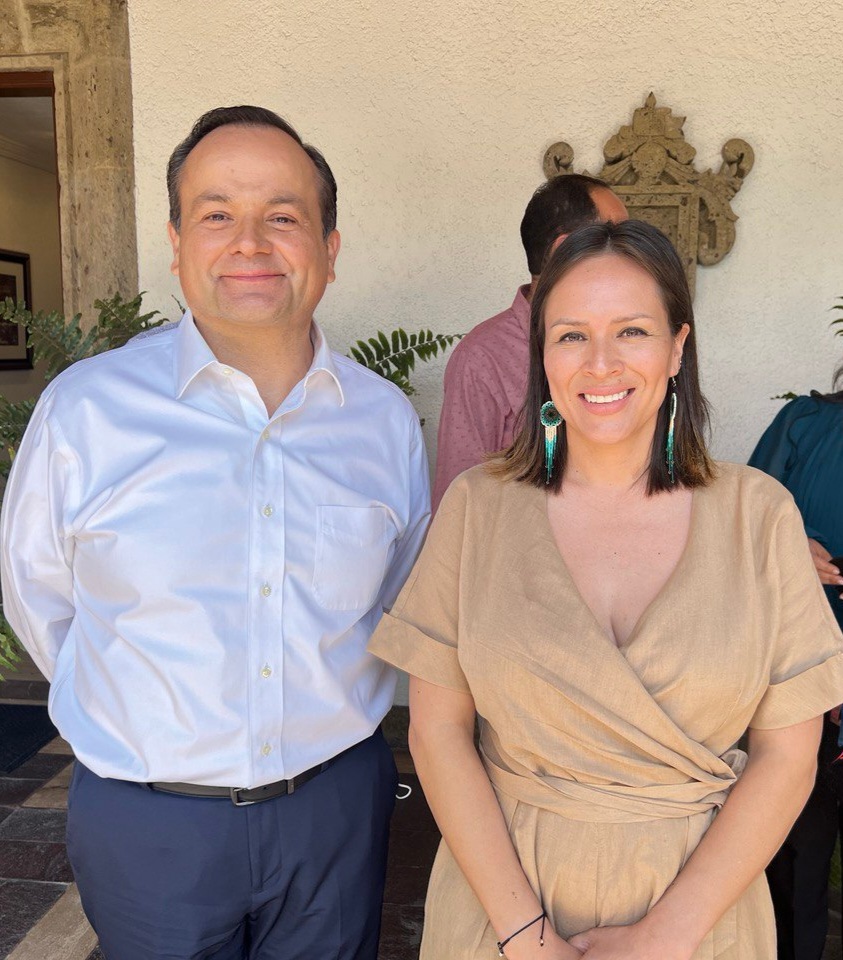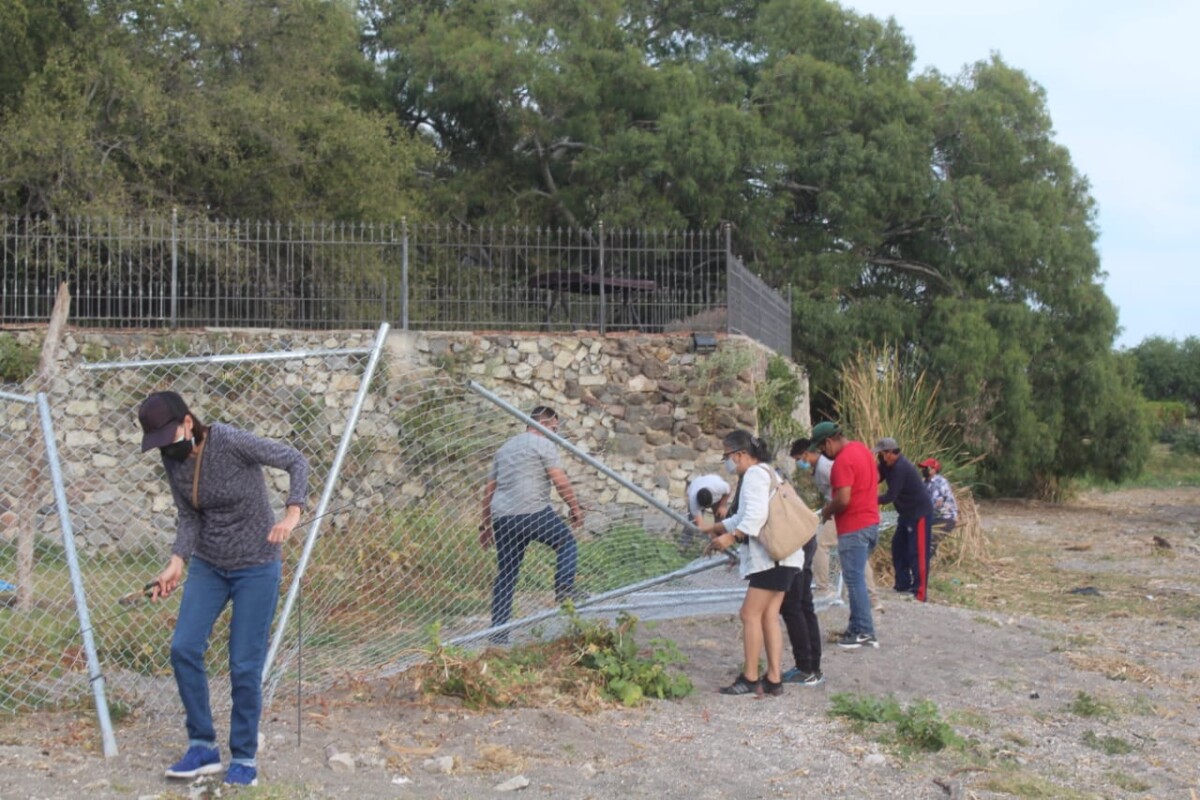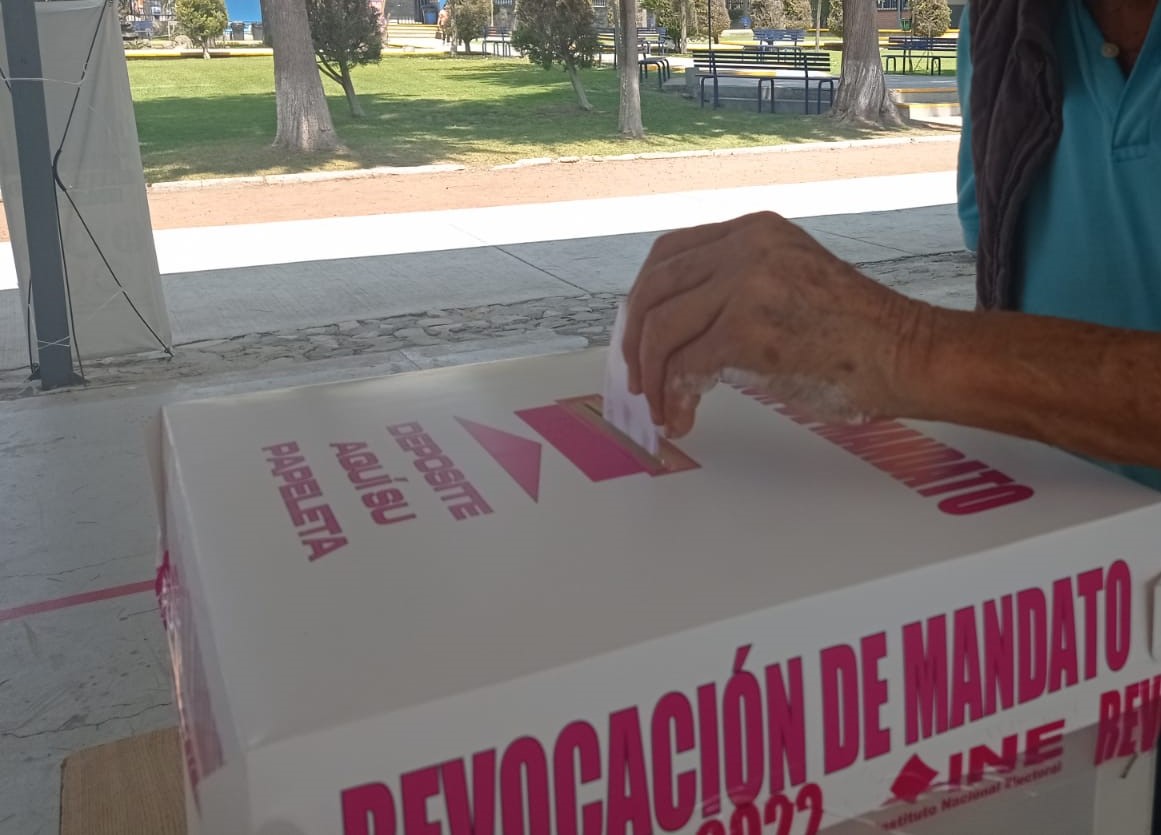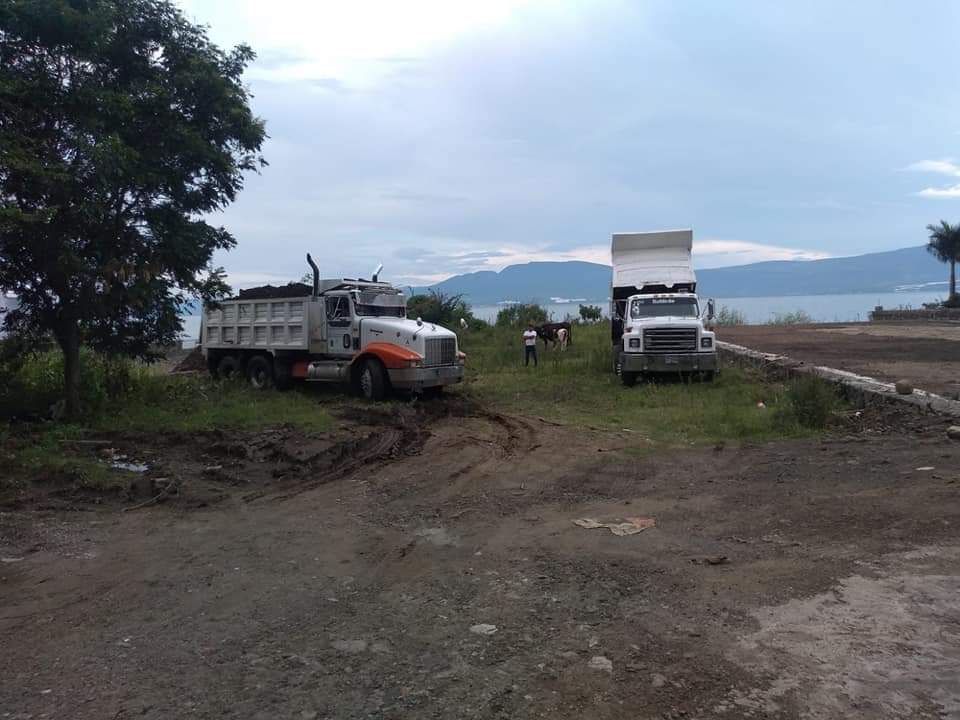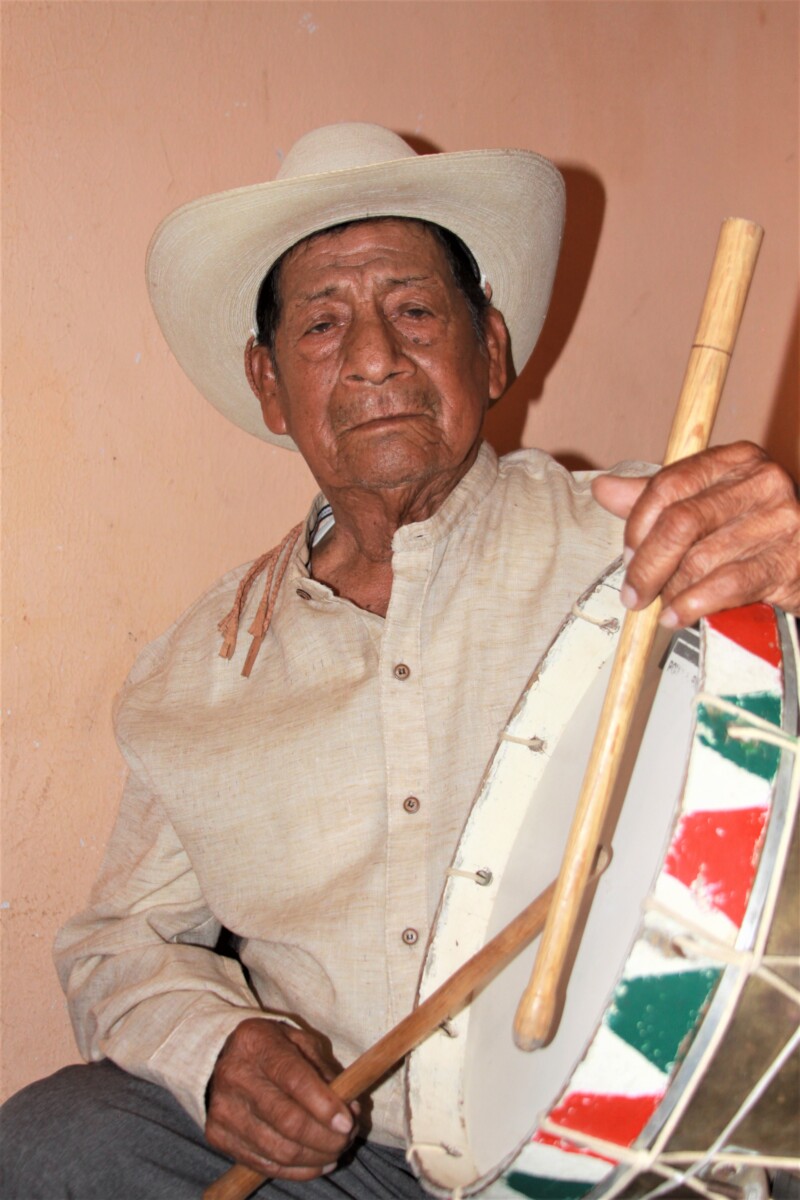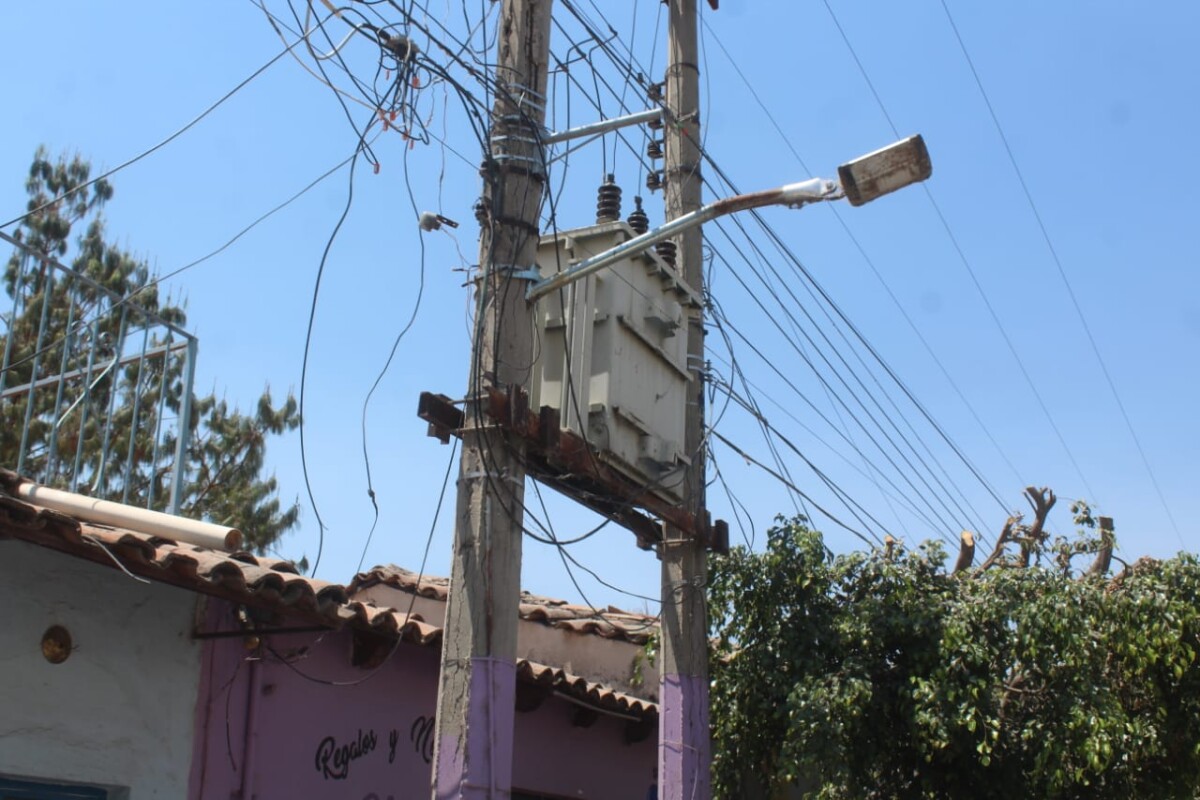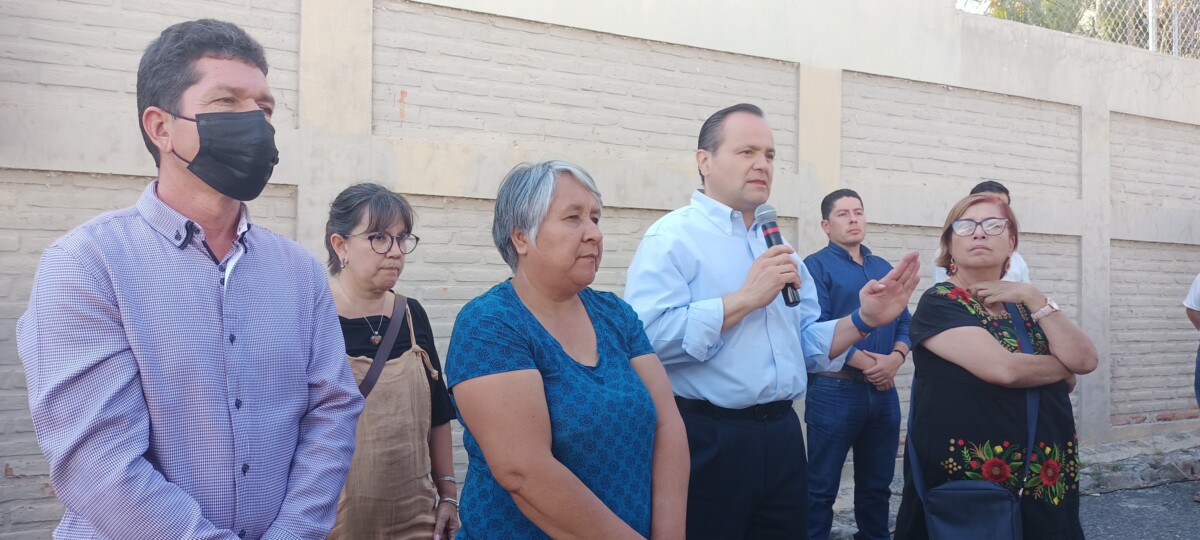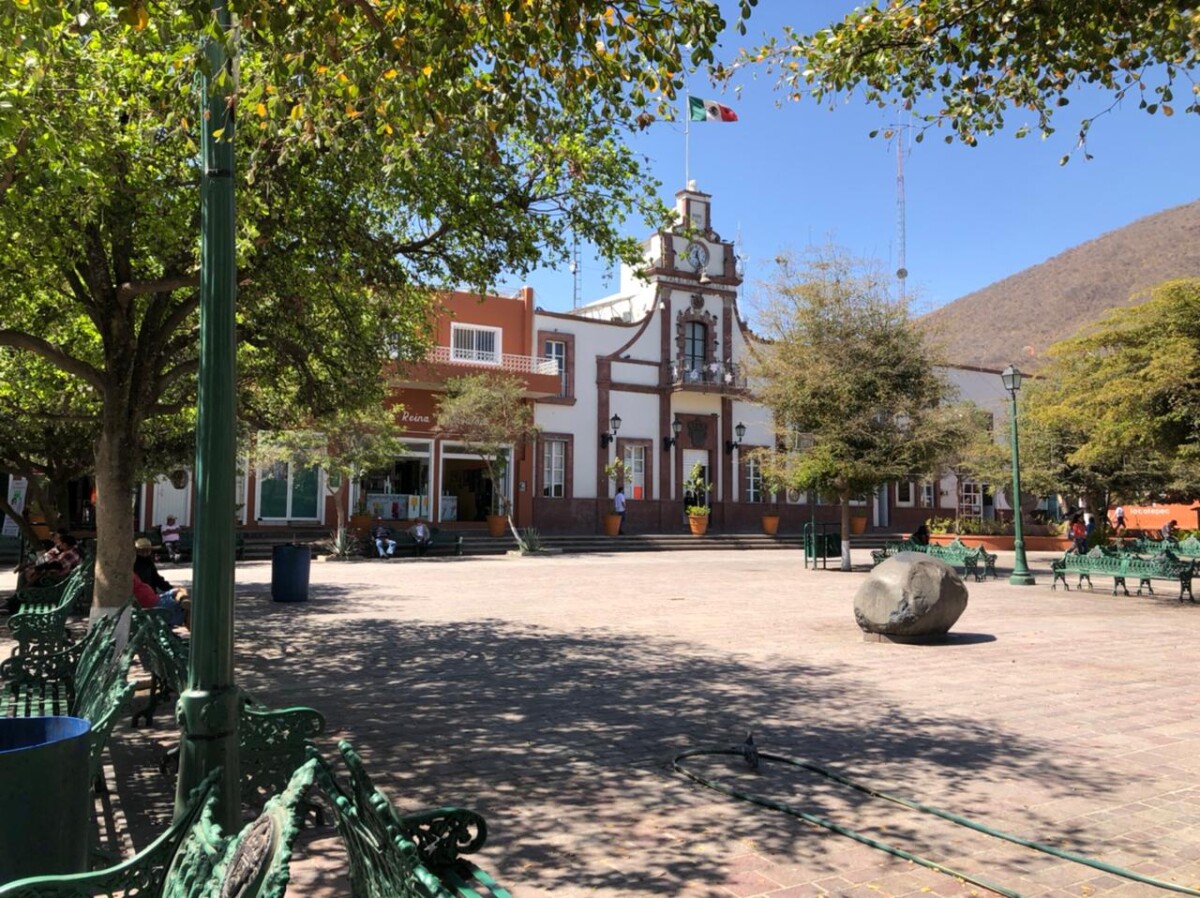en inglés
Mayor announces improvements and funding for Ajijic and Chapala
The mayor of Chapala (right) accompanied with the Jalisco Secretary of Tourism.
Editor.- Chapala Mayor Alejandro de Jesús Aguirre Curiel announced the projects to improve the Pueblo Mágico aspects of Ajijic and the tourist areas of Chapala in his presentation of the Model of Magic Towns of Jalisco.
Aguirre Curiel shared details of the project and the funds to improve infrastructure and tourism on social media.
«This project consists of four thrusts that will allow our Pueblo Mágico, Ajijic, to better receive visitors and show off its beauty: Analysis and improvement of mobility in the town; Establishing a Tourist Agent; Analysis and improvement of its visual presentation; and waste management».
The mayor emphasized that the objective is to improve the quality of life of the people who live in Ajijic and the people who visit it, so he considered this an important policy «for Ajijic and for Chapala this news means a lot, because it strengthens the economic and touristic growth of our municipality, without losing the traditions and culture that identify us».
During the press conference held at Casa Jalisco on April 11, a first investment of 20 million pesos was announced for the start-up of the Magical Towns Model in the nine towns of the state that have this distinction.
Finally, Alejandro Aguirre, recognized the influence of Governor Enrique Alfaro Ramírez in the designation of Ajijic a Pueblo Mágico, highlighting its traditions and excellent climate as some of its main attractions, without forgetting the influence of the retired residents of the Expat community.
Translated by Patrick O’Heffernan
Looking at Life in Lakeside
By: Patrick O’Heffernan
I am so looking forward to this weekend’s celebration of the Passion of Christ. Although my wife and I bought our house in Ajijic over 5 years ago, we actually did not move in until almost 3 years ago. The preceding years we visited, managed a ranch, and stayed in various homes around Lakeside. We were never here during Semana Santa and Easter, so this will be my first. I experienced Christmas in Baja when I was in my 20’s, but I understand the two holidays and the attendant celebrations are nothing alike.
I am going to find out, for sure. The route of the Passion of Christ goes right by my house. My neighbors and I will be in a mirador that overlooks the pathway up to the Stations of the Cross in the tépalo, and the return procession will go down our street. Dale Hoyt Palfrey of the Guadalajara Reporter published an excellent photo essay of the Passion, from past years from the trial and flogging all the way up the mountain to the crucifixion; going through her photos made me realize the scale of the event.
I am not a Catholic, although my mother insisted I go to the local Catholic grammar school (supposedly “better” than the public school), so I am familiar with the story. But the focus was always on Easter, with Good Friday and Palm Sunday distant seconds. We did the stations of the Cross on Good Friday in the church attached to the school, but that was it. The idea of the entire story being reenacted with full costumes, supporting casts and a crucifixion is a mind-boggling reminder of the power of religion.
In retrospect, it shouldn’t be. In Indonesia I watched the procession of the Hindu festival Thaipusam where thousands of devotees followed long lines of entranced men and women who pierced their cheeks with spears and put hooks through their skin attached to ropes dragging weights behind them So, following an actor playing Christ carrying a cross up the trail through the hills is not surprising, but the scale of the event here in Lakeside is impressive.
I was always taught to respect people’s practice of their religion, as long as it did not harm anyone (apparently the people in Thaipusam felt no pain while in a trance and healed very quickly). I understand that the Passion may involve hardship and maybe pain for some of the actors, but that is their passion and it is to be respected, as is the whole celebration and the devotion of the people in it and following it, Expats and Mexicans.
Which makes me think a little about Santa Semana and tourism. I was out on the streets today in downtown Ajijic and they were very crowded. People were shopping, cruising the sidewalks with takeaway margaritas and beers, enjoying themselves, as they should be.
But various government officials in Lakeside’s municipalities have predicted as many as 2 million visitors will arrive in Chapala and 180,000 in Jocotepec. Seems high to me – that would be 25% of the population of Guadalajara arriving and spreading out through the towns of Chapala. In Jocotepec, that would be an increase in population greater than all of Lakeside. But that is what they said, so we reported it. And we will report on the actual numbers, if they are calculated.
While numbers like that may be good for business – assuming everyone can actually get here and find a place to park and a restaurant table – I worry that the sheer numbers of people on holiday may not encourage respect for the Passion. If you are here on a holiday weekend, you are having fun, and there is probably no way you are going to be one of the 2,000 people following the procession up to the crucifixion, so you might be tempted to ignore the solemn event taking place. But, like I said, this will be my first Good Friday celebration in Ajijic and I may be pleasantly surprised by the respect of the crowds. I hope so.
The ‘anti-fencing’ movement will clear the beaches of the rebuilt fences
Chain-link fence located near the pumping plant being removed for the second time. Photo: Sofía Medeles.
Sofía Medeles (Ajijic).- Pueblos Unidos de la Ribera activists removed a chain-link fence for the second time they claim had been placed in federal territory of Lake Chapala.
The action took place last Friday, April 8, in the area that had been allegedly illegally fenced near the re-pumping plant of the Municipal Potable Water and Sewage System (SIMAPA), to the east of the town.
On this occasion, not only was the fence removed, but it was cut up, and the activists used hammers to destroy the bases where the posts are placed, so that the fence could not be put up again, as happened last time. Although the land owners tried to intimidate them by taking video, the activists were not deterred.
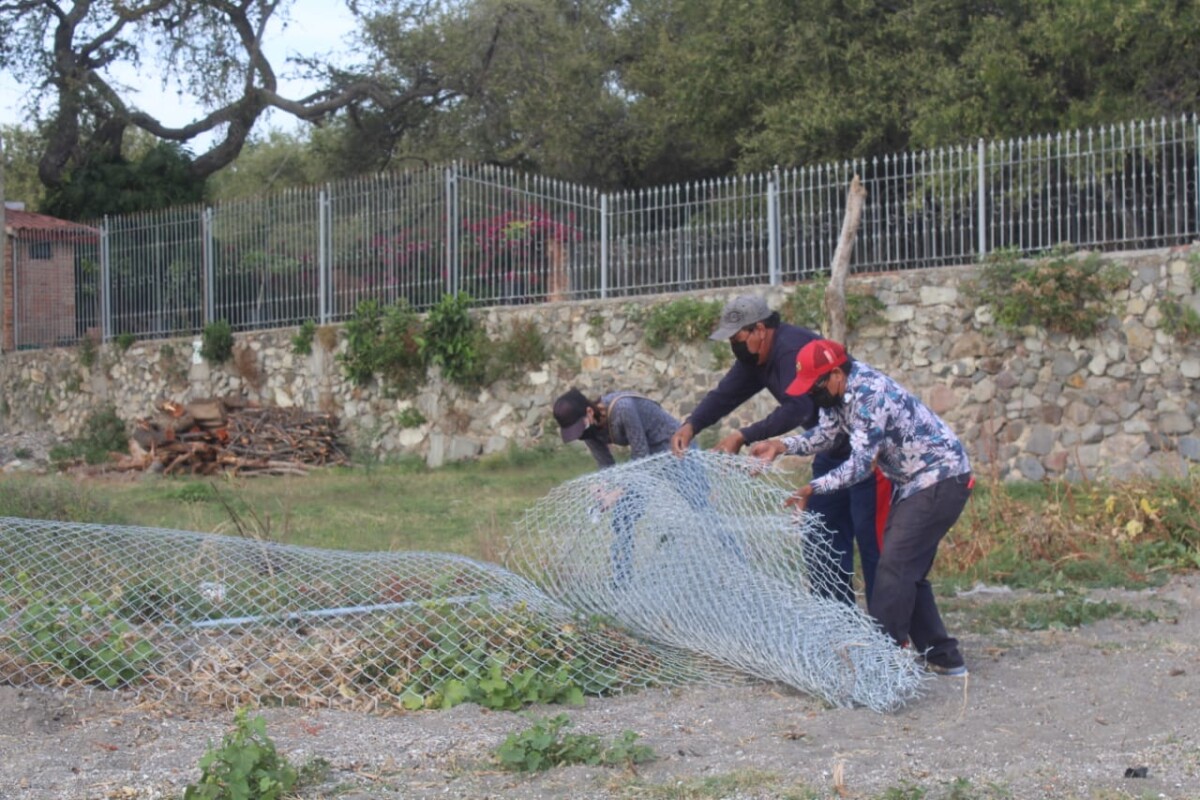
In addition to removing the fence, the bases where the pipes are placed were also cut and covered to prevent it from being put up again. Photo: Sofía Medeles.
At the end of the meeting, there was talk of returning to the beach in the area known as «Tío Domingo», where in August and September last year, at least seven fences were removed. Of all these, five have been rebuilt, and two of the lands allegedly illegally occupied have been planted with crops to justify their takeover by the adjacent landowners. Two of the alleged illegal fences have been rebuilt twice.
Also, two more disputed fences were recently removed to the east of Ajijic, at the end of Donato Guerra Street; in one of these, the owners chose to remove the entire fence and, in the other, they raised it again, however, it was removed again.
The meetings of the group to act against this type of invasion will be announced through social networks. Members of the «anti-rejas» movement say that the participation of the Ajijitecos and other interested parties is important, since it is an issue of interest for all the residents of the area around the lake.
Translated by Patrick O’Heffernan
Less than ten percent of District 17 voters participated in the recall election
Only 27,168 cast their vote in the lake area.
Héctor Ruiz Mejía.- Only 9.97 percent of the electorate in District 17 participated in Sunday’s vote on the Revocation of Mandate on Andrés Manuel López Obrador (AMLO).
Of the 272,259 people who were expected to go to the polls on April 10 in the 15 municipalities that make up the district, only 27,168 cast their vote. Of these, 25,270 voted in favor of AMLO’s continuation as president, 1,548 voted to revoke his mandate and 350 left their ballot blank.
Between Chapala and Jocotepec, seven thousand two votes were cast, of which six thousand 351 were in favor of AMLO, 558 against him, and 100 were null votes.
Nationally, voter participation was also low, according to INE only between 17 and 18.2 percent of those registered on the nominal list cast their vote; Jalisco registered 9.06 percent, one of the states with the lowest participation. The election had no impact because, it required at 40% of the current electoral roll.
Translated by Patrick O’Heffernan
Warning of forgery of deeds in Chapala
Trucks in the Bajío area, west of Ajijic. File 2021.
Editor. White-collar criminals have set their sights on Chapala to seize land in federal zones, using false deeds and corrupt notaries who use their positions to issue forged documents with which they try to take over public spaces.
The Government of Chapala, the Association of Notaries Public of the State of Jalisco and the State Government have called on the population to oppose bad practices of public notaries, after investigating that, in complicity with private individuals, they have falsified documents to take possession of land in federal zones.
The municipal authorities, in coordination with the state authorities, have undertaken a strategy to stop illegal acts by notaries and individuals who try to take possession of land in Chapala. The Dirección General de Delitos Patrimoniales y Financieros de la Fiscalía de Jalisco, has opened investigations into irregularities committed in the municipality.
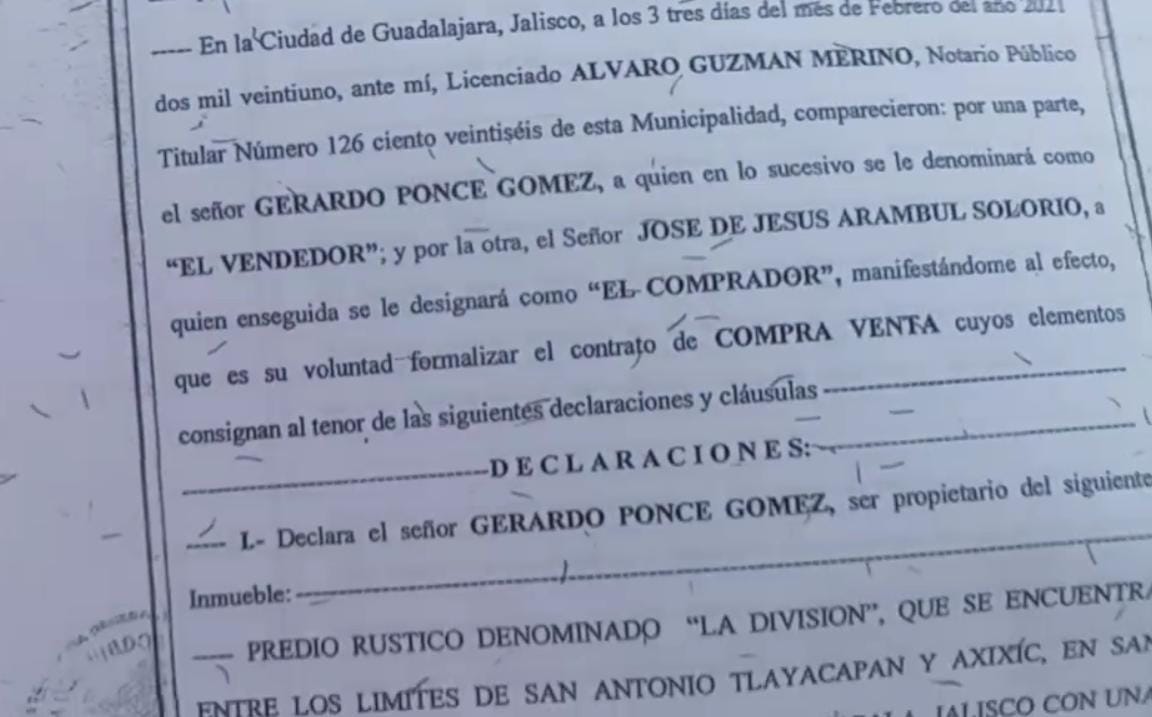
Part of a deed, which Jaime Natera López, President of the College of Notaries of Jalisco, qualified as false as it was signed by a notary who was suspended and out of his jurisdiction.
The Notary Association of Jalisco asked for regulations to insure that those who want to acquire a property, do so based on the law, and condemning people they labeled as «loafers», who want to take possession of land illegally. The Association vowed it would not protect any person who tries to do illegal acts.
«We are not going to overrule anyone, but we must consider the Registrar who participates in the appraisals and the public registry of property. I am totally convinced that some of these (fake) deeds can give legal certainty,» said Jaime Natera Lopez, President of the College of Notaries of Jalisco in a media interview.
For the last ten years the problem of invasions in the hills and beach areas of Lake Chapala has been growing at an accelerated rate, without any authority trying to put a stop to the invasions. in many cases illegal the takeovers of property have been facilitated by corruption by private individuals and notaries public.
Among the public notaries that are endorsed as legitimate in Lakeside are: Jorge Chávez, Sergio Macías, Juan Carlos López, Sergio Macías (father), Luis Enrique Ramos, Juan José Rodríguez, Adriana Villaseñor, as well as notaries public from La Barca, Ocotlán, Ayotlán, Tototlán and Atotonilco, on the condition that they are present. The misuse of notarial procedure is punishable with two to six years of imprisonment.
Translated by Patrick O’Heffernan
Lakeside Chronicles:
Leonardo Saucedo better known as «El Chiri,» is a dancer by inheritance. From the age of seven his grandfather assigned him to the Lord of Huaje in Jocotepec to whom he offers his dances during the festivities. Photo: María Reynozo.
By: María del Refugio Reynozo Medina
Since he was a child, Leonardo Saucedo learned dance from his father Leobardo Saucedo Valentín, a dancer who performed the representation of the conquest in the town of Nextipac, municipality of Jocotepec.
Leonardo watched the rehearsals with rapt attention. He clearly remembers the characters; La Malinche, Hernán Cortés and Cuauhtémoc.
“-Get up, great monarch, Hernán Cortés is coming….” La Marina began in one of its dialogues in the colloquium that recreated the episode of The Conquest. It lasted more than three hours and up to 60 actors participated among dancers and musicians with guitar, stringed instruments, and drums.
At the age of seven Leonardo suffered a very strange illness. Small wounds appeared on a large part of his body that oozed. His grandfather entrusted him to the Lord of the Huaje, the Christ carved on a huge gourd tree found in the vicinity of San Pedro Tesistan and located in the chapel formerly known as the Chapel of the Immaculate Conception in the municipal capital of Jocotepec.
She promised him that if he healed him, she would give him her little grandson so that he could praise him through dance. So, they undertook the pilgrimage from Nextipac to the temple of the Lord of the gourd tree, walking, praying, dancing and the seven-year-old boy carrying despite his illness, a heavy wooden drum.
Don Leonardo «El Chiri» is now 86 years old, he remembers that moment and tears come to his eyes.
“I was even hot when I arrived,» he says.
After fifteen days, the boy was completely healed.
His father used to take to the Lord of gourd tree for the festivities of «the dawn» (rockets, cinnamon, bread and ringing of bells).
In addition to his love for dancing, he remembers that he used to help his father in the fields every day. During harvesting the fruits or burying the seeds in the middle of the furrows he would go over the dialogues. Though the official rehearsals were in the afternoon when the days in the fields were over.
As a dancer «El Chiri» went to Zacoalco de Torres, San Luis Soyatlán, Tizapán el Alto, Santa Rosa, Atequiza and Ixtlahuacán de los Membrillos.
Now he says he is sad to see himself getting old, however, as long as he exists he will also live his fervor for the crucifix made from the gourd tree. Every time he goes to Jocotepec, the first thing he does is to visit the image and take a candle to it. Every year he is also present at the feast. “Although I may be crawling, I have to go.”
«El Chiri» they call him in town because one day in a soccer game, ten minutes from the end, he scored an Olympic goal that led his team to victory. “It was a fluke,» he was told.
«El Chiri» learned very well his side as an actor not only as a dancer. He recreated characters with different voices. ‘The Indians did some voices, he says, and the conquistadors did others.”
One day when they were walking up the hill on their way to Cajititlán for a presentation, the woman who was going to play La Malinche fell into a stream. By the time they reached their destination she no longer had a voice. «El Chiri» had no problem representing the female voice and completing the picture. He had a very good memory, although «we had no school,» he says.
In those days they had for school a leafy mango tree, a piece of smoked board and his teacher.
However, he came to learn not only his own dialogues but those of everyone else.
Now his memories are vague, and among them he’s lost some incomplete stanzas of what was the splendor of the colloquies of La Conquista.
“Silence and little morulla, if you want to see this dance.
Listen to me, so many women, which one is the most murmuring,
is she braided or is she hairy.
Adorned with little rags shut those little lips.
Don’t disturb Juan Guarín epa maistro of the violin
Touch me the dwarfs to dance them here …”
Translated by Sydney Metrick
Citizens worried about damaged electric transformer after fire
Transformer that caught fire last Saturday, April 2, located on Ocampo Street, almost at the intersection with Francisco Villa. Photo: Sofía Medeles.
Sofía Medeles (Ajijic).- An electrical transformer of the Comisión Federal de la Electricidad (CFE) caught fire last Saturday, April 2 and as of the closing of this edition, was still unattended.
The damaged transformer is located on Ocampo Street, almost at the intersection with Francisco Villa, one block from the neighborhood of Las Seis Esquinas. Citizens reported that it had been leaking a liquid for several days.
In a story that circulated through social networks, a complaint was made after the fire and it would be attended on Monday, April 4. This publication stated that the liquid was very harmful and put neighbors or passers-by at risk.
The damage to the device did not affect the electricity or water service of the residents near the area. The neighbors fear for their safety because an explosion could occur due to overheating and the lack of liquid.
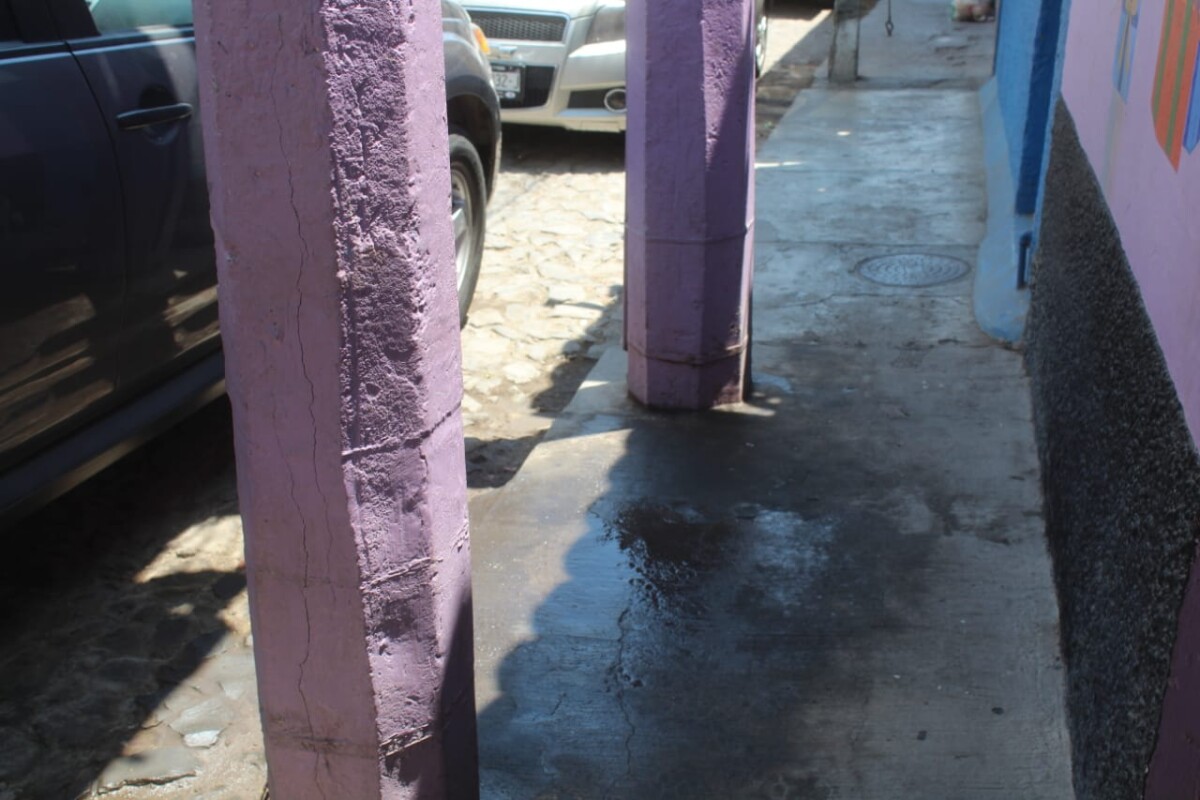
Liquid spilling from the transformer. Photo: Sofía Medeles.
«On Saturday there was a firefighting unit that apparently contacted CFE. A while later, CFE sent a person with a forklift truck, but he only looked at the transformer and left. He did not even take five minutes to attend to the problem,» the interviewee said.
«Now that the smoke produced by the fire is polluting, just like the oil that is spilling. It should be reported to ecology so that they can put pressure on the CFE with an official letter,” the complainant added.
Ajijic acting delegate Maximiano Macias Arceo commented that the problem was reported to him on Saturday. He said that neither he nor the personnel of the delegation or the municipality could regulate the device, since it is federal property of the CFE and only they could fix it.
«We made the report to the commission (CFE), we cannot intervene, neither we nor the public lighting department, since it is a federal matter. We have made the report again, because the oil in the transformer is toxic and we will follow the situation until it is repaired,» concluded Macías Arceo.
Translated by Nita Rudy
Chapala’s City Hall presents major water treatment and drainage project for Riberas del Pilar
Chapala Municipal president, Alejandro de Jesús Aguirre Curiel, with microphone in hand, the municipal agent Ana María Huerta Rivera, the councilman of Riberas del Pilar, Jesús González Amezcua, and two of the members of the new neighborhood committees.
Jazmín Stengel (Chapala).– The Chapala City Council presented a project for the installation of a sewage system to benefit the population of the Riberas del Pilar. The work is estimated to cost 68 million pesos, to be paid in equal parts by the municipal government and by residents. The Council claims that the properties that currently have private septic systems are contaminating the environment and the project is needed.
After introducing Ana María Huerta Rivera as agent for Riberas del Pilar, and asking the residents to watch for increasing shoreline invasions of federal zones, President Alejandro de Jesús Aguirre Curiel, presented the details of the project.
«This is a proposal, which consists of installing much-needed drainage. It also includes a water treatment plant. We have to do this together, the municipal government and each one of the taxpayers.» He added that the proposal has been reviewed for feasibility.
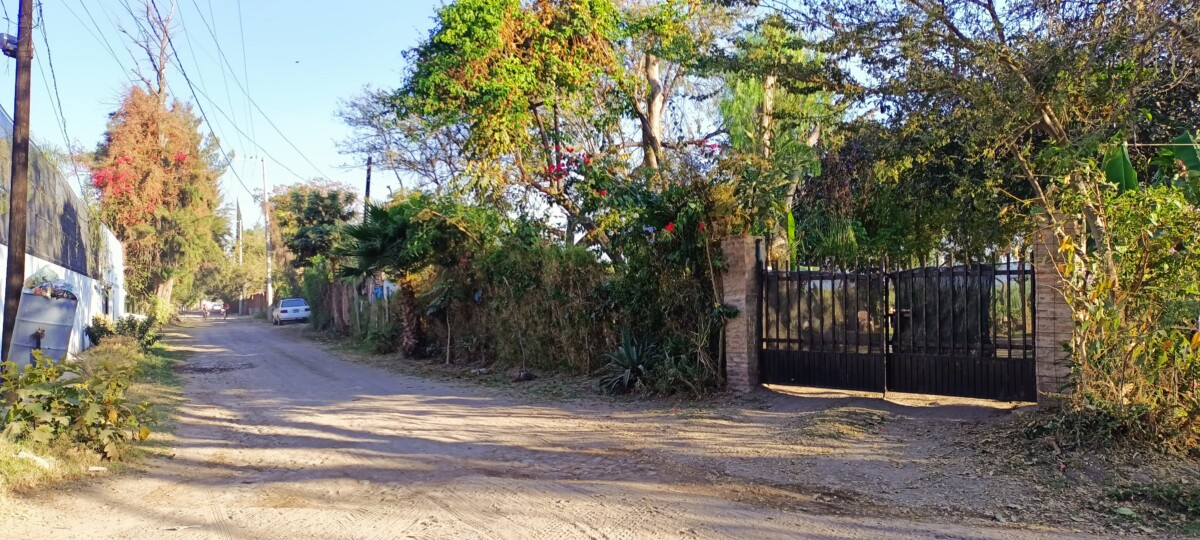
The plant would be built on Paseo del Lago street, on the corner of San Mateo towards San Lucas street, in the Riberas del Pilar municipal agency. Credit: Jazmín Stengel.
The project, presented on April 5, includes drainage lines, a modular treatment plant which would be located between San Lucas and San Mateo streets on the shores of the lake, and the connector. It would be built out in one single six-month stage.
The current municipal administration asked residents to agree to the 50/50 cost split. Cost-sharing is necessary as there is not any available support from federal or state programs. In addition, officials said that they need 25% of the total cost of the project in advance to start the work. Residents have about 45 days to contribute the first 17 million pesos. If the funds are not raised, they will be returned to those who have contributed. The deadline was established by the approximately fifty residents present at the meeting. Government representatives assured that they had 34 million pesos available for the project.
In order to collect the remaining 34 million pesos from Riberas del Pilar residents, each homeowner will be charged 70 pesos per square meter of land, business owners will be charged 100 pesos per square meter. Riberas del Pilar covers 237 hectares, and contains about registered 1,500 properties.
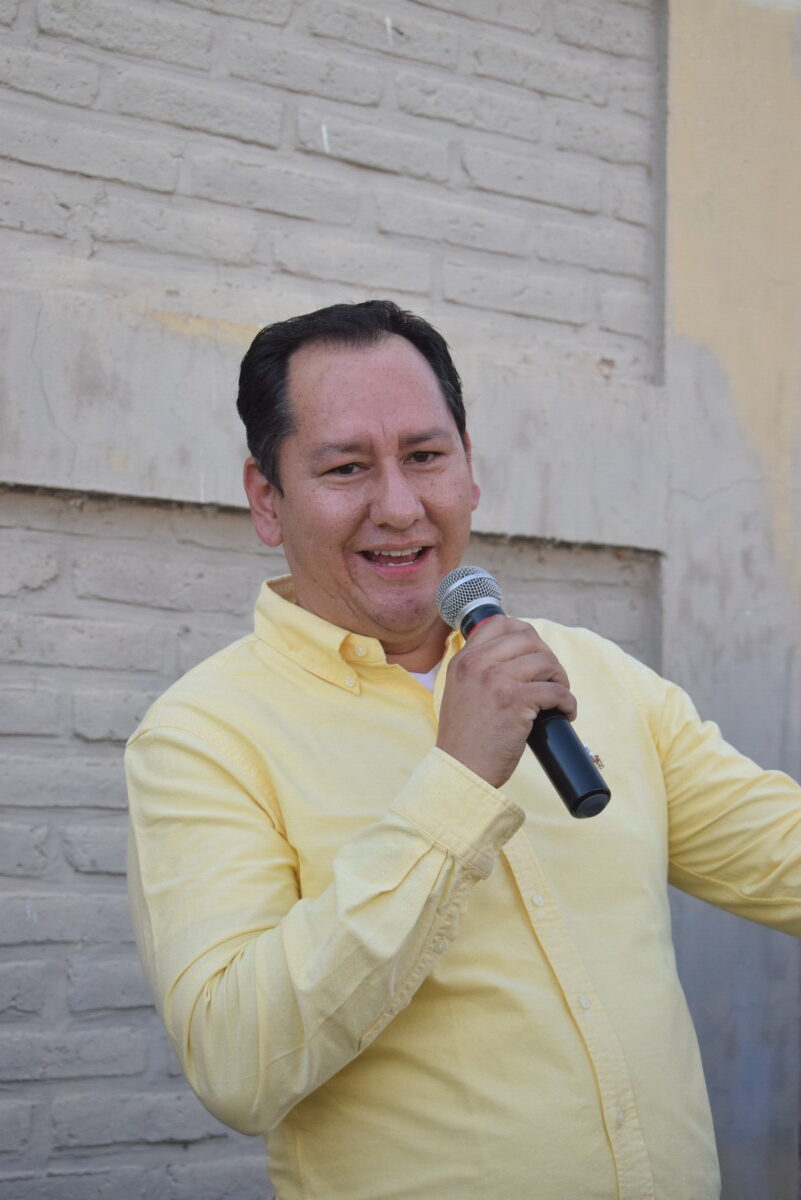
Fernando Antonio Monreal Mendoza, engineer in charge of the work and director of the Municipal Potable Water and Sewage System (SIMAPA).
There will be two ways to quote the fee and make the corresponding payment. The first is bring your property deed Municipal Water and Sewage System (SIMAPA) office, located in the new administrative unit located 62 Hidalgo Avenue. The second option is to wait for the formation of one of four neighborhood committees that are expected to be formed.
Connections from the houses to the public sewage system are not included in the cost of the project, or in the fees collected. Homeowners and business owners will be responsible for their own costs to connect to the system. Current estimates are 14,000 – 18,000 pesos per house. Officials said that anyone who does not pay the required fees for the project will not have the right to connect to the public drainage, and will be fined in the future for environmental contamination.
Present for a short time during the meeting were the municipal president Alejandro de Jesús Aguirre Curiel, the director of the Municipal Potable Water and Sewage System (SIMAPA) Fernando Antonio Monreal Mendoza, Juan Carlos Pelayo, advisor to the City Council, as well as council members, and the recently-appointed delegado, Ana María Huerta Rivera.
Translated by Amy Esperanto
Despite ‘no budget’ Jocotepec’s City Hall payroll increases
Last year, the Government of Jocotepec registered a total of 547 civil servants. Photo: File.
Héctor Ruiz Mejía (Jocotepec).- Despite the fact that authorities claim that the municipality of Jocotepec has a limited budget, during the last four years the number of City Hall workers increased from 398 to 547.
According to a report issued by the Tax Administration Service (SAT) under folio number 22NA4165087, corresponding to fiscal years 2018 to 2021, the municipality increased its workforce by 37.43% during that period.
Although in daily discourse, the municipal president of Jocotepec, José Miguel Gómez López, states that Jocotepec has little budget, the information obtained through transparency shows the opposite.
In 2018 City Hall had 398 workers; this increased to 540 in 2019 and dropped to 534 in 2020. In 2021, 547 City Hall workers were on the payroll.
Total salaries and wages of civil servants as reported increased the budget by 25.17%.
In 2018, the municipality of Jocotepec paid a total of 52,560,210.72 pesos (about US$2.6 million); in 2019 the amount was 56,743,975.04 pesos (about US$2.8 million). In 2020 it increased to 67,505,644 pesos (about US$3.3 million).
2021 closed with a payroll expense of 65,789,990 pesos (about US$3.28 million) together with a section of salary exempt payments of 3,143,411 pesos (about US$157,000) totaling 68,933,401 pesos (about US$3.44 million).
After the cutback of federal funds, the municipal president reduced the salaries of councilmen 50% and salaries of employees in positions of trust 30 percent as a cost saving measure. Despite these reductions to payroll, 2021 was the year in which the most money was spent on salaries.
Translated by Nita Rudy
Jocotepec restaurants expect profitable tourism in Easter Week
The approximately 14 restaurants that make up the area known as Piedra Barrenada expect a large influx of tourists during Easter Week. Photo: Héctor Ruiz.
Héctor Ruiz Mejía (Jocotepec).- Jocotepec expects a major influx of tourists during Easter Week, with a concomitant increase in economic revenue. The 14 restaurants of the tourist – gastronomic zone of San Juan Cosalá known as Piedra Barrenada, located in San Juan Cosalá, are preparing for a return to “normal” after a drop of approximately 75 percent in sales during last year’s holiday season.
According to Víctor Manuel Loza Ornelas, director of Tourism and Artisan Promotion, after two years of a complicated panorama in the sector due to the pandemic, this year more than 18,000 visitors are expected during Easter Week. Loza Ornelas stated that the economic revenue expected is approximately 4 million pesos per week (about US$200,000), or 8,000,000 pesos in total during the vacation season (about US$400,000). This is double the 2,000,000 pesos that are normally generated per week. «The economic revenue in a bad season, let’s say, goes above two million pesos, but in this season that amount doubles», he said.
Saulo Rameño Castañeda, manager of the 42-year-old Bar Piedra Barrenada Restaurant, is also optimistic. «The truth is that the last two years were very complicated. Although we were open last year, we did not take in what we expected. I estimate that there was a 50 percent decrease in sales. However, the outlook for this year is favorable,» he said. The businessman added that during the Holy Days this year, they will open longer hours, from 8 am. to 8 pm. In this busiest time of the year, they host up to 600 diners per day.
The year that had the greatest impact on the drop in sales was 2020, when health authorities forced businesses to close their doors for a month due to the sanitary contingency.
Translated by Elisabeth Shields
© 2016. Todos los derechos reservados. Semanario de la Ribera de Chapala
